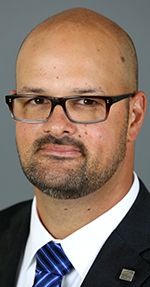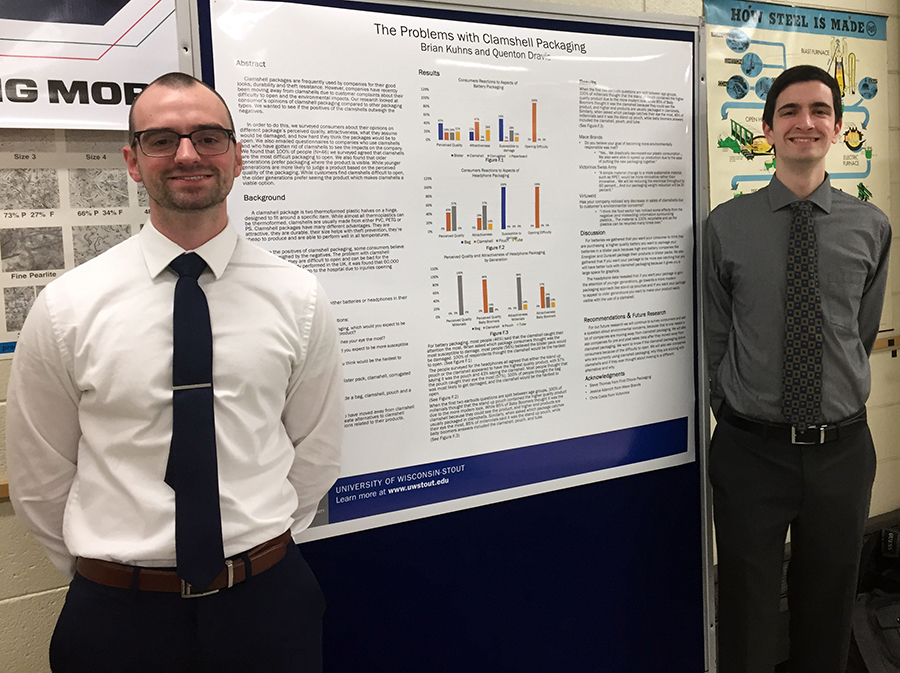Millennials seek out sleek, modern packaging and don’t care if they see the actual product, compared to baby boomers and Gen Xers who want to see that a product is in good condition before buying it.
That is the determination of research conducted by University of Wisconsin-Stout senior packaging students Brian Kuhns and Quenton Dravis, who graduated Dec. 15.
Kuhns,  of St. Paul, will work at Prent Corp. in Janesville in late January as a design engineer. Dravis, of Prescott, will work at Milwaukee Tools as a packaging engineer. As part of their packaging Senior Research Seminar class last semester taught by John Spartz, associate professor in English and philosophy, the two studied the problems of clamshell packaging.
of St. Paul, will work at Prent Corp. in Janesville in late January as a design engineer. Dravis, of Prescott, will work at Milwaukee Tools as a packaging engineer. As part of their packaging Senior Research Seminar class last semester taught by John Spartz, associate professor in English and philosophy, the two studied the problems of clamshell packaging.
“We know a lot of consumers complain about opening clamshell packaging,” Kuhns said.
The question they had was if clamshell packaging impacts whether consumers buy a product. Using batteries and headphones as their products, they tested consumers’ response to blister pack, clamshell, corrugated cardboard and pouch packaging. “Every single person interviewed found clamshells the hardest to open,” Kuhns said.
However, when they started looking at those whom they surveyed, they found older people tended to want to see a product before purchasing it and were more comfortable with the clamshell packaging.
Millennials, those born in the early 1980s to 2004, liked the sleek, modern look of pouch packaging, even if they couldn’t see the items. “It really tells us if you are trying to attract an older generation visibility is key,” Kuhns said. “If you are trying to attract a younger generation it comes down to looking modern in your packaging.”
The 21 students presented their research at the end of the semester in Fryklund Hall.
New professor brings new perspectives
It was the first time Spartz taught the course, but students said they found his research knowledge an asset and learned new skills they can carry into their careers.
“This helps us a lot,” Dravis said. “He gives us a whole different aspect and teaches us to present and not just give information.”
Spartz has a technical communication and user experience background. “I ask students to do human-centered, primary research,” he said. “They need to learn to communicate within cross-functional teams and with different stakeholders.”
Spartz said he also encouraged students to think about the best methods to conduct their research, evaluate their findings and then share those findings clearly through various media.
UW-Stout seniors Jeff Wallace, of Lakeland, Minn., and Anthony Diaz, of Baraboo, researched the effects of the essential oil rosemary mixed with olive oil on ground beef quality and shelf life. They found that the rosemary mixture extended the shelf life of ground beef by about three days when exposed to light.
However, keeping ground beef without any essential oils in a dark environment extends shelf life by about 14 days. They designed a package in a sealed environment with a light dampening cover that could be peeled back, allowing consumers to view the ground beef yet largely keeping it out of the light.
“One of the biggest costs to retailers is the spoilage of product,” said Diaz, who graduated Dec. 15 and will work at Medtronic, a medical device company in Moundsview, Minn.
They also found consumers were not fans of rosemary oil in the beef.
“When it comes to research, Dr. Spartz was perfect for the job,” Diaz said. “He was always asking questions about our research, which made it a better project. It helped me think about what I was trying to do.”
Wallace agreed. “I really enjoyed having so much knowledge in the process of research and how to communicate it well,” Wallace said. “If you can’t communicate your research, it’s of no value.”

Packaging seniors Roger Connell and Tom Oakland researched the use of aloe vera coating to increase the shelf life of fruits and vegetables. They tried dipping, spraying and brushing aloe vera gel on the food items. The fruit that showed promising signs was blueberries, staying fresher by about two days. More study would be needed on the issue, they agreed.
Spartz helped students refine their research to get the best possible information, said Connell, of Elmwood.
Oakland agreed. “I think he helped me a great deal,” said Oakland, of Menomonie. “He encouraged us to represent our data and was supportive to have us present our research.”
UW-Stout is one of only a few schools in the U.S. and the only school in the UW System that offers a bachelor’s degree in packaging.
UW-Stout is Wisconsin’s Polytechnic University, with a focus on applied learning, collaboration with business and industry, and career outcomes.
###
Photos
John Spartz
Quenton Dravis, at left, and Brian Kuhns, both recent UW-Stout packaging graduates, studied how different generations respond to packaging.




